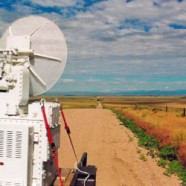
Problem/Background
Radio tagging devices have been available to the wildlife research community for over twenty+ years now. Large VHF radio devices, or tags, have operating lives measured in months or years, but devices weighing 1g or less are limited to only a few weeks of battery life. Since the tag’s maximum weight is determined by the size of the animal, medium- to long-term telemetry studies are limited to animals weighing generally more than 50g. This excludes a large group of smaller species, including most Passerines (songbirds) and most bat species.

cross band transponder system
Approach/Objectives
Commercial radio tags transmit a short VHF radio pulse (10-20mS) every 1-2 seconds, and multiple birds can be tagged in the same area and distinguished by different tag frequencies. The observer usually listens to the tag for only a small proportion of its operating life. Much of the tag’s battery life is therefore wasted. If a tag were to transmit only when required and consume nearly zero power otherwise, the tag’s life would be extended considerably. This crossband transponder development effort achieves that objective. This project was supported by the DoD’s Strategic Environmental Research and Development Program, and is now being supported by the National Science Foundation.
A conventional radio tag circuit consists of a VHF radio transmitter switched by a pulse generator. For this project, a microwave pulse detector replaces the pulse generator. The new crossband tag delivers a VHF radio pulse only when it detects a specific microwave pulse trigger, which is initiated by the observer. Its power consumption in ‘listen mode’ is very low, so that a 1g tag should operate for at least 18-24 months with regular, but short, periods of interrogation. A radar transmitter delivers the microwave pulse; the bearing of the crossband tag can be inferred (fairly accurately) from the azimuth of the radar dish.
Approach/Objectives
Commercial radio tags transmit a short VHF radio pulse (10-20mS) every 1-2 seconds, and multiple birds can be tagged in the same area and distinguished by different tag frequencies. The observer usually listens to the tag for only a small proportion of its operating life. Much of the tag’s battery life is therefore wasted. If a tag were to transmit only when required and consume nearly zero power otherwise, the tag’s life would be extended considerably. This crossband transponder development effort achieves that objective. This project was supported by the DoD’s Strategic Environmental Research and Development Program, and is now being supported by the National Science Foundation.
A conventional radio tag circuit consists of a VHF radio transmitter switched by a pulse generator. For this project, a microwave pulse detector replaces the pulse generator. The new crossband tag delivers a VHF radio pulse only when it detects a specific microwave pulse trigger, which is initiated by the observer. Its power consumption in ‘listen mode’ is very low, so that a 1g tag should operate for at least 18-24 months with regular, but short, periods of interrogation. A radar transmitter delivers the microwave pulse; the bearing of the crossband tag can be inferred (fairly accurately) from the azimuth of the radar dish
Most telemetry studies are not automated, i.e., a human observer usually monitors the tags. At Earthspan, we are developing an automated system to trigger, detect, display, and record tags from the radar’s location. If required, a human observer using conventional biotelemetry equipment can still monitor the reply signal. In that case the observer can be positioned anywhere within the VHF reception range, a situation analogous to Secondary Radar

Earthspan crossband tag
We hope that crossband tag range (in addition to bearing) may also be derived by computing the delay between the outgoing microwave pulse transmission and receipt of the VHF reply signal; accuracy has yet be determined for this parameter. In due course, the addition of a micro-controller will make possible pulse-coded reply capability (so that many tags can use a single VHF reply frequency, thus speeding up scan times), adaptive screening of spurious stimulation from other radars in the environment, and more accurate ranging.
Results
Earthspan has designed, produced, and tested prototype crossband transponder tags that weigh approximately 1 g. Earthspan has also designed and procured a 3 GHz radar system that is mounted on a trailer and is easily portable behind a truck or SUV. Field-testing and optimization efforts are underway
